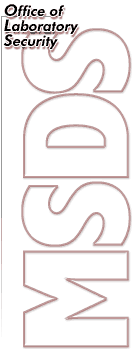

  |
|||||||||||||||||

|
MATERIAL SAFETY DATA SHEET - INFECTIOUS SUBSTANCES SECTION I - INFECTIOUS AGENT NAME: Fusobacterium spp. SYNONYM OR CROSS REFERENCE: F. necrophorum, F. mortiferum, F. nucleatum, F. varium, F. gonidiaformans, F alocis, F. pseudonecrophorum, F. salci, F. ulcerans CHARACTERISTICS: Anaerobic gram-negative bacilli, non-sporulating, slender cells with tapered ends or pleomorphic, irregular staining SECTION II - HEALTH HAZARD PATHOGENICITY: Indigenous flora on all mucosal surfaces, normal inhabitants of human cavities (mouth, upper respiratory tract, gastro intestinal tract and urogenital tract); can cause purulent or gangrenous infections; infections involve all regions of body - respiratory, urogenital and gastrointestinal tracts, abscesses, septicemia, pleurisy, necrotizing gingivitis; usually occurring when mucosal damage related to surgery, trauma or disease occursEPIDEMIOLOGY: Worldwide; F. nucleatum most common Fusobacterium species found in clinical infections, however, F. necrophorum is most virulent species HOST RANGE: Humans and animals (horses, cattle, sheep, goats, pigs, fowl and others) INFECTIOUS DOSE: Not known MODE OF TRANSMISSION: Part of normal flora that invade tissues after surgical or accidental trauma, edema, anoxia and tissue destruction (from infection with other organisms or malignancies); animal bites; other predisposing factors include antibiotic treatment (eliminate aerobes and foster invasiveness) or immunosuppressive treatment INCUBATION PERIOD: Not clearly defined COMMUNICABILITY: Not transmitted from person-to-person SECTION III - DISSEMINATION RESERVOIR: Humans and animals (alimentary canal and feces of healthy ruminants and pigs) ZOONOSIS: Yes - wound contamination by animal bites or feces VECTORS: None SECTION IV - VIABILITY DRUG SUSCEPTIBILITY: Sensitive to penicillin, clindamycin, chloramphenicol DRUG RESISTANCE: Erythromycin and macrolides SUSCEPTIBILITY TO DISINFECTANTS: Susceptible to disinfectants - 1% sodium hypochlorite, 70% ethanol, 2% glutaraldehyde, iodines, phenolics, formaldehyde PHYSICAL INACTIVATION: Sensitive to moist heat (121░ C for at least 15 min) an dry heat (160-170░ C for at least 1 hour) SURVIVAL OUTSIDE HOST: Manure - 292 days; culture exposed to air -7 days; soil - 56 days SECTION V - MEDICAL SURVEILLANCE: Presence of foul-smelling discharge or gas in tissue suggests infection, microscopic examination, GLC and molecular probes FIRST AID/TREATMENT: Surgical drainage, alone or together with antibacterial therapy IMMUNIZATION: None PROPHYLAXIS: Preventive treatment with penicillin SECTION VI - LABORATORY HAZARDS LABORATORY-ACQUIRED INFECTIONS: 1 reported Fusobacterium infection SOURCES/SPECIMENS: Feces, wound exudates, necrotic tissues, respiratory and urogenital specimens PRIMARY HAZARDS: Accidental parenteral inoculation; direct contact of mucous membranes (or wound, cuts on skin) SPECIAL HAZARDS: None SECTION VII - RECOMMENDED PRECAUTIONS CONTAINMENT REQUIREMENTS: Biosafety level 2 practices, containment equipment and facilities for activities involving infectious specimens and cultures of F. necrophorus PROTECTIVE CLOTHING: Laboratory coat; gloves when direct contact with infectious materials is unavoidable OTHER PRECAUTIONS: None SECTION VIII - HANDLING INFORMATION SPILLS: Allow aerosols to settle; wearing protective clothing, gently cover spill with paper towel and apply 1% sodium hypochlorite, starting at perimeter and working towards the centre; allow sufficient contact time (30 min) before clean up DISPOSAL: Decontaminate before disposal; steam sterilization, chemical disinfection, incineration STORAGE: In sealed containers that are appropriately labelled SECTION IX - MISCELLANEOUS INFORMATION Date prepared: May, 2001 Prepared by: Office of Laboratory Security, PHAC Although the information, opinions and recommendations contained in this Material Safety Data Sheet are compiled from sources believed to be reliable, we accept no responsibility for the accuracy, sufficiency, or reliability or for any loss or injury resulting from the use of the information. Newly discovered hazards are frequent and this information may not be completely up to date. Copyright © [Material Safety Data Sheets - Index]
|
| Last Updated: 2001-05-25 | |||